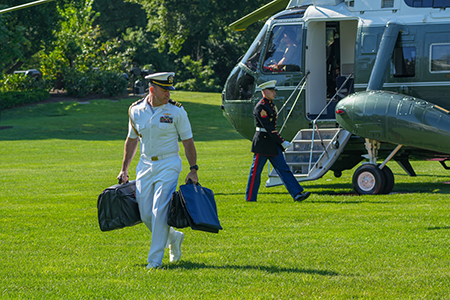"No one can solve this problem alone, but together we can change things for the better."
Avoiding Nuclear War Through Nuclear Failsafe
September 2024
By Steven Andreasen
At a time of heightened global tensions, when a handful of leaders with only a few minutes of decision time could determine the world’s fate, the next U.S. president must prioritize nuclear risk reduction. Faster, more powerful delivery systems and new technologies, including cyber and artificial intelligence, are increasing the risk of nuclear blunders.1 The best way to reduce these risks is global nuclear failsafe.2

“Failsafe” refers to safeguards that prevent the unauthorized, accidental, or mistaken use of a nuclear weapon. In the United States, these safeguards could involve nuclear policy or force posture, such as adopting a no-first-use policy or modifying the nuclear triad. They also could include procedures that would strengthen the decision-making process for nuclear use, such as placing guardrails around the president’s sole authority to authorize the use of nuclear weapons. Further, they could involve the design of nuclear weapons or delivery systems, for example, by ensuring that they are built to prevent a terrorist from using a stolen bomb or by installing a system that would allow for the postlaunch destruction of nuclear weapons or their associated delivery systems if launched by mistake.
Hollywood has highlighted these risks through iconic performances by its biggest stars. In the 1964 movie “Failsafe,” Moscow is destroyed by a U.S. nuclear bomber due to computer error. The box-office hit “Dr. Strangelove” involves an unauthorized U.S. nuclear attack on Russia instigated by the mad commander of U.S. nuclear forces. In the 1990s, “Crimson Tide” depicted a tense standoff between a U.S. nuclear submarine captain and his executive officer over whether a U.S. nuclear strike on Russia has been properly authorized.
The epilogue to “Crimson Tide” notes that Washington was taking steps to ensure that the scenario in the movie could not happen. Those steps were mandated in an independent review by the Kirkpatrick Commission, which the George H.W. Bush administration initiated at the urging of Senator Sam Nunn (D-Ga.).3 In 1992 the commission authorized more than 50 steps to prevent unauthorized, accidental, or mistaken nuclear use, but that was more than 30 years ago during the digital Stone Age. Since then, the world has entered a new era, with new threats and new technologies.
The good news: In the 2022 National Defense Authorization Act, Congress mandated a new independent failsafe review.4 The Biden administration included a commitment to conduct this review in its Nuclear Posture Review with the results due this fall.5
The responsibility will fall to the next U.S. president to ensure that the review’s recommendations are implemented, to think creatively about enacting additional steps that might be needed and to institutionalize a process of future failsafe reviews to keep pace with evolving threats. Finally, the next president should make a major push to internationalize failsafe reviews in every nuclear-armed state. These reviews can be done without any agreements, treaties, or verification.
Each nation with nuclear arms has a responsibility to reduce the risk of nuclear blunders and can benefit from unilateral actions and similar actions taken by other nuclear powers. Leaders must give themselves every available tool to prevent a mistake from turning into a catastrophe.
ENDNOTES
1. Ernest J. Moniz and Sam Nunn, “The Return of Doomsday,” Foreign Affairs, Vol. 98, No. 5, (September/October 2019), https://www.foreignaffairs.com/articles/russian-federation/2019-08-06/return-doomsday.
2. Euro-Atlantic Security Leadership Group, “Advancing Global Nuclear ‘Fail-Safe,’”
February 2023, https://www.nti.org/wp-content/uploads/2023/02/EASLG-Statement_GNFS_FINAL-022723.pdf.
3. U.S. Department of Defense, “Final Report of the Federal Advisory Committee on Nuclear Risk Reduction (FARR),” n.d., https://archive.org/details/FinalReportoftheFederalAdvisory
CommitteeonNuclearFailsafeandRiskReductionFARR/mode/2up.
4. The 2022 National Defense Authorization Act states, “The Secretary of Defense shall provide for the conduct of an independent review of the safety, security, and reliability of covered nuclear systems. The Secretary shall ensure that such review is conducted in a manner similar to the review conducted by the Federal Advisory Committee on Nuclear Failsafe and Risk Reduction.” National Defense Authorization Act for Fiscal Year 2022, Pub. L. No. 117-81, 135 Stat. 1541 (2021).
5. The 2022 Nuclear Posture Review states, “[A]s directed by the National Defense Authorization Act for Fiscal Year 2022, [the Department of Defense] will commission an independent review of the safety, security, and reliability of U.S. nuclear weapons, [nuclear command, control, and communications], and integrated tactical warning/attack assessment systems.” U.S. Department of Defense, “2022 Nuclear Posture Review,” October 27, 2022, p. 13, https://media.defense.gov/2022/Oct/27/2003103845/-1/-1/1/2022-NATIONAL-DEFENSE-STRATEGY-NPR-MDR.PDF#page=49.
Steven Andreasen, the National Security Council’s staff director for defense policy and arms control from 1993 to 2001, teaches national security policy and crisis management at the Hubert H. Humphrey School of Public Affairs at the University of Minnesota.
